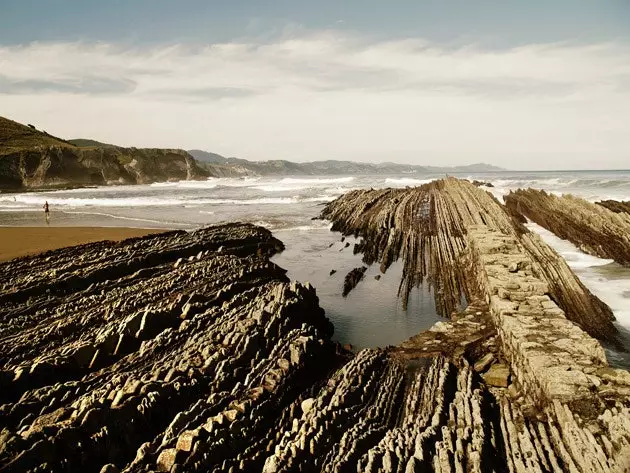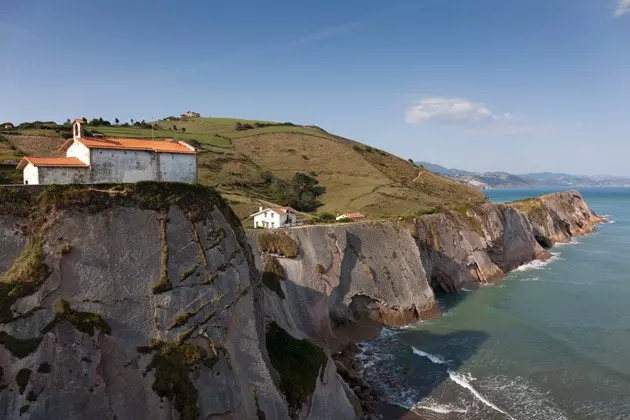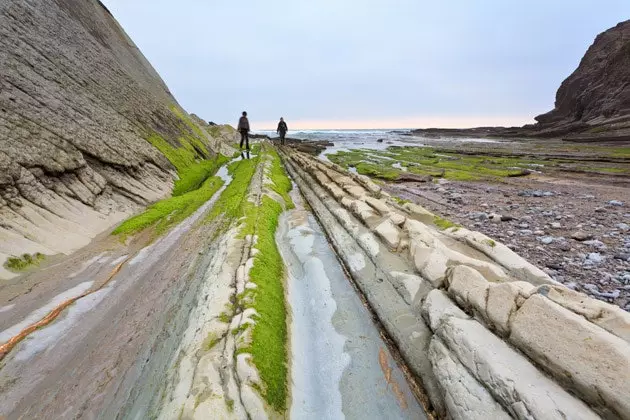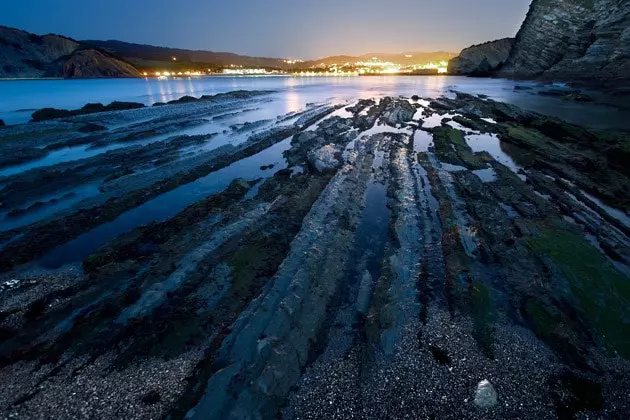
We are going to Zumaia to caress meteorites
Let's feel the meteorite that exterminated the dinosaurs and 70 percent of the planet's species 65 million years ago. At least, its pulverized remains: in Algorri cove we run our finger across a layer of dark clay containing hard-packed ash, microtektites (drops of molten glass that shoot out after asteroid strikes), and a conspicuous concentration of iridium (an element as rare on Earth as it is abundant in meteorites).
Other clues about the crime: in each of the above rock layers, scientists find more than a hundred species of fossils and microfossils , ancient life, varied and abundant. Then everything is interrupted by that mysterious dark stripe. And in the next stratum there are barely half a dozen of those species left: here a sudden and massive extinction occurred. It is the boundary between the Cretaceous and the Tertiary era. A fucking blowout.
To go down to Algorri cove and touch meteorite dust, we must approach to a hermitage erected on the very edge of a cliff, hanging over Itzurun beach, in Zumaia . It is a temple consecrated to Saint Elmo, Christian martyr, patron saint of sailors and an example of survival in the worst catastrophes: a couple of Roman emperors submerged it in pits full of snakes and worms, doused it with boiling oil, ripped out its teeth with tongs, filled his mouth with molten metal, put him in a spiked barrel to be thrown from a mountain, roasted him on a grill, tied his hands and feet to four horses to be quartered, and there was no way. One day a bolt of lightning struck by his side that split open the earth, but he continued to preach impassively. And that's why sailors invoke it to protect themselves from lightning.
From the hermitage of San Telmo, we go down a valley towards Algorri cove, already chewing on the question of this excursion: what are the chances of surviving we have if we are struck by lightning or an asteroid or even if the Earth gets too hot. Zumaia, with its extraordinary stone record of the planet's history, is one of the best places in the world to investigate it. so does Jan Smit, the Dutch geologist who spent good seasons squatting in this cove , tapping the hammer and taking samples of the mysterious dark layer. We, like Smit, must wait for low tide to approach the base of the cliff, where erosion has carved out a small channel. If we want to identify the stratum containing the asteroid's ashes, we'd better come with one of the guided tours offered by the Basque Coast Geopark .

The hermitage of San Telmo
smit he is one of the scientists who proved that the extinction of the dinosaurs was due to the impact of an asteroid . On this cliff in Zumaia, he gathered some of the evidence that led, after many investigations around the world, to the scene of the crime: the Chicxulub death crater in Mexico, the 180-kilometer-diameter sinkhole, the footprint of a meteorite that it also produced tsunamis, earthquakes measuring 13 on the Richter scale, devastating continental-scale fires, and a winter of ash and sulfur that killed two-thirds of life on the planet. In addition to the extinction of the dinosaurs, three other tremendous events were recorded on the cliffs of Zumaia and Deba: a change in the Earth's magnetic polarity, a sudden drop in ocean level, and major global warming with which we can compare the current data.
"Right now we are experiencing the sixth mass extinction in the history of the planet," says Miguel Delibes Jr. , the biologist, who also makes a pilgrimage to Algorri and scares us with a calm and smiling expression. “The rate of species disappearance is hundreds or thousands of times higher than the normal rate, we recorded a rate comparable to that of the five great extinctions in history. And it is due to the human species, which has transformed the Earth with a force as great as those that mark changes in geological eras.” Delibes remembers, smiling, that the disappearance of the dinosaurs was fantastic for the proliferation of mammals, including us, and that if we now overheat the globe, we and many species will have a hard time, but tropical lizards will be happy . The champion of survival, the saint Telmo of nature, is the sea urchin: he witnessed the brutal events that take place on the cliffs of Zumaia and he was the only species that survived all.
The fossils of sea urchins are pieces highly appreciated by the Navarrese shepherds , who carry them in their bag to protect themselves from lightning. That's how it counts Miguel Sanchez-Ostiz , writer and collector of amulets. Dinosaurs ruled the planet, sea urchins survived. They have been slowly crawling across the ocean floor for millions of years, with a conspicuous lack of concern. Not the strongest survive but the most adaptable. What will the sea urchin have, wonders Delibes, good genes or good luck? Probably good luck, he says . The Navarrese shepherds had already sensed it.
The chance of being killed by lightning this year is one in ten million. (Let's not trust ourselves: it is still more likely than hitting the six numbers of the Primitive). With climate change, it is not known: Delibes compares our planet to a dishwasher that is losing its nuts and that continues to work, with more and more rattling and noise, without anyone knowing if it is going to burst or not. And if another meteorite like the one of the dinosaurs falls, Jan Smit offers some consolation: "An asteroid like this would not kill all of humanity, only 99%". Let's load the pocket with hedgehog fossils and pray to San Telmo.

One step through the flysch is ten thousand years
ONE STEP, TEN THOUSAND YEARS
From San Telmo and Algorri, a path takes us through one of the most spectacular spots on the Basque coast : cliffs, hanging valleys, unraveled mountains, waterfalls that jump into the sea, coves of former smugglers...
Under our boots the flysch, a rocky pastry that alternates layers of limestone, marl and sandstone . They are sediments accumulated over millions of years at the bottom of the ocean, in which the great events and cyclical changes of our planet were recorded, and which emerged when the Iberian plate collided with the European plate. Each stratum is the page of an immense geological book : “There are some of the greatest books in the world”, says the geologist Asier Hilario , scientific manager of the Deba-Zumaia protected biotope, “but they are missing entire chapters. This flysch is extraordinary because it allows us to read the history of our planet uninterruptedly, layer after layer, page after page, from one hundred million years ago to fifty million years ago, along ten kilometers of coastline.” We take a step and go back ten thousand years. Another step, another ten thousand years . In a short walk we go through the time when the Pyrenees sprouted, by the extinction of the dinosaurs, by glaciations, heating and temperate eras. Everything can be read in this landscape, if the experts help us to look.
Hilario is the author of El biotopo del flysch (Deputation of Guipúzcoa, 2012), a highly recommended field guide to read the cliffs while we walk, to observe the transformation of the planet at our feet. On the terrain, a network of marked trails and information panels also gives us the basic information to interpret the landscape.
It is worth walking at least a couple of hours along this coastal path, bordering cliffs, inlets, meadows, farmhouses, woods, to reach Sakoneta cove . There, during low tides, one of the most colorful landscapes extends: the intertidal flat, an extensive platform of parallel stone blades , which advance hundreds of meters out to sea, testimony to the ancient coast that was torn down and crushed, bite by bite, by the waves and the wind.

An extensive platform of parallel stone blades
Another couple of hours of walking take us along the cliffs of Mendata and the hermitage of Santa Catalina, to the town of Deba. There we can browse the black flysch strata and look for fossils from an ancient coral environment on the breakwater that separates the river from the beach. We have therefore reached the reefs that populated that underwater Basque Country with a tropical environment.
It's time to finally stretch your legs, gobble up your sandwich and look southeast to see Mount Arno , the limestone mountain from which the rocks with fossils of this breakwater were extracted. It is time, finally, to pay homage to the authors of the Gipuzkoan landscape: the trillions of sea creatures that deposited their tiny shells, shells and mineral skeletons at the bottom of the ocean, those calcium carbonate sediments that formed reefs and that when they emerged became the Basque mountains. It is normal that our legs hurt a little: we have walked millions of years.
PRACTICAL TIPS:
- Algorri Interpretation Center . Guided tours of the flysch, by land and by sea. Juan Belmonte Street, 21. Zumaia. Phone: 943 143100.
- The Basque Coast Geopark it extends through Zumaia, Deba and Mutriku. They offer routes and guided tours of the flysch and the region.
- If we walk from Zumaia to Deba, we can return to the starting point by train.
- A guide to walk along this coast interpreting the landscape: The flysch biotope. A journey through life and time. Field guide and tours to understand the secrets of a very geological biotope (Asier Hilario, Diputación de Guipúzcoa, 2012).
- A great documentary: Flysch, the whisper of the rocks, by the filmmaker Alberto Gorritiberea and the geologist Asier Hilario.
Cultural.es documentaries - The cliffs of Zumaia
- Cultural.es documentaries - The cliffs of Zumaia
